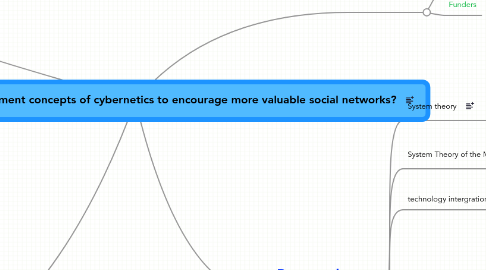
1. author
1.1. puppets
1.2. stories
1.3. personal knowledge
1.4. personal skills
1.5. ethical awareness
1.6. Dsylexic
1.7. Describe structure as the Society of Mind
1.8. designer as collaborator
1.9. Case studies
2. Context
2.1. Technology has increased life expectancy
2.1.1. http://en.wikipedia.org/wiki/Tragedy_of_the_commons
2.1.2. http://en.wikipedia.org/wiki/Rachel_Carson#Silent_Spring
2.2. How we perceive, communicate and act in this world
2.2.1. This is embodied via anthroporphism, story telling and mythologies
2.2.2. Paul Taylor nous.org.uk
2.2.3. Buckminster Fuller
2.3. Knowledge expressed through technology
2.3.1. Aristotle Atomistic world view
2.3.1.1. The intuiative has been relegated to popular culture
2.3.1.1.1. Ignorance of the Sublime - Victoria Nelson
2.3.1.2. Fairy tales and the art of memory are the last vestigies of an aural culture
2.3.1.3. http://www.amazon.com/Digital-Sublime-Myth-Power-Cyberspace/dp/026213439X
2.3.1.4. - Adrian Johns in The Nature of the Book
2.3.2. hierarchies of power
2.3.3. Privation of thought and Conception of the individual – Jorge Luis Borg
2.3.4. Death of Nature and the loss of the World Soul
2.3.4.1. The Death of Nature: Women, Ecology, and the Scientific Revolution: Books: Carolyn Merchant by Carolyn Merchant
2.3.4.2. http://en.wikipedia.org/wiki/Natural_Capitalism
2.3.4.3. http://www.mcdonough.com/cradle_to_cradle.htm
2.3.4.4. Plotinus Cosmic World View
2.3.5. Computer paradigm
2.3.5.1. Van Neuamn Turing Computer
2.3.5.2. Dreyfus, H. l. (1999). What Computers Still Can't Do, A Critique of Artificial Reason, The MIT Press.
2.3.5.3. Weizenbaum, Joseph. Computer Power and Human Reason : From Judgment to Calculation. Harmondsworth: Penguin 1984.
2.3.5.4. Haladay as a reperesentation of the need to replicate the mind
2.3.5.5. http://en.wikipedia.org/wiki/Rebecca_Goldstein
2.3.6. Mind Body Split and scientific determinism
2.3.6.1. Descartes
2.3.6.2. the invention of the microscope
2.3.7. Norbert Wiener First wave cybernetics
2.3.8. Marx - Alienation and over production
2.3.8.1. Simmel
2.3.8.2. Comodity Fetishism
2.3.8.2.1. Guy Debord
2.3.9. Creating an atomised and rationalistic society
2.3.9.1. The Glass Bead Game - Hermen Hesse
2.3.10. Hierarchies and transcendence
2.3.11. Mary Shelly Frankenstein
2.3.12. Heron - Daedalus - Automata
2.3.13. Jacques Ellul - The Technological Society
2.3.14. http://www.amazon.co.uk/Consumer-Culture-Modernity-Don-Slater/dp/0745603041
2.4. A rational world view vs Intuition
2.4.1. Magic, Rhetoric, and Literacy: An Eccentric History of the Composing Imagination - By William A. Covino
2.4.2. Magic, Science and Religion and the Scope of Rationality - Stanley Jeyaraja Tambiah
2.4.3. raymond williams
2.4.4. Chomsky - manafacturing consent
2.4.5. Sloterdijk
2.4.6. Max Weber - disenchantment
2.4.7. Fredric Sublime
2.4.8. 'A Short History of Myth karen armstrong
2.4.9. http://spacecollective.org/obvious/2815/An-Appendix-Logos-vs-Mythos
2.5. What can be done?
3. reader
3.1. Education
3.2. Funders
4. Proposal
4.1. System theory
4.1.1. David Bohm
4.1.2. Systems Theory
4.1.2.1. Batson and the re concptetion of form and content
4.1.3. 2nd Wave Cybernetics and Open systems
4.1.4. Think of systems at multiple levels
4.1.4.1. Holarchy - Arthur Koestler
4.1.5. Global Systems
4.1.5.1. Fritjof Capra
4.1.5.2. Holistic conception of the enviroment
4.1.5.2.1. Gaia Hyptohosis
4.1.5.2.2. Arne Næss
4.1.5.2.3. http://en.wikipedia.org/wiki/Brian_Goodwin
4.1.5.2.4. http://en.wikipedia.org/wiki/Joanna_Macy
4.1.5.2.5. From Cradle to Cradle
4.1.5.2.6. Natural Capitalism
4.1.5.3. Danger of spirtuality and transcendence
4.1.5.3.1. teilhard de jardin
4.1.5.4. ken wilber
4.1.6. Society of Mind
4.1.6.1. We see reality through our sense - Heidegger
4.1.6.2. Structural Coupling
4.1.6.2.1. The Tree of Knowledge: The Biological Roots of Human Understanding. Random House, 1992.
4.1.6.3. Autopoisis
4.1.6.3.1. Embodied Knolwedge
4.1.6.3.2. Philosophy in the Flesh: The Embodied Mind and Its Challenge to Western Thought - George Lakoff,
4.1.6.3.3. Ken Fairclough – community formation
4.1.6.4. Knowledge can be more fluid
4.1.6.4.1. Hereclitus vs Plato
4.1.6.4.2. http://en.wikipedia.org/wiki/Sapir-Whorf_hypothesis
4.1.6.4.3. http://en.wikipedia.org/wiki/Conceptual_blending
4.1.6.4.4. Cut and Paste metaphor - can represent the transience of information
4.1.6.5. Associationism
4.1.6.5.1. John Lock - Associationism and information trails
4.1.6.5.2. Lanaguage Web - Jean H. Achison
4.1.6.5.3. neural theory of language
4.1.6.6. The Act of Creation - bisociation of matrices
4.1.6.7. History is alive
4.1.6.8. key stone
4.1.6.9. http://en.wikipedia.org/wiki/Raphael_Lemkin
4.1.6.10. Memes
4.1.6.11. http://en.wikipedia.org/wiki/Daniel_Goleman
4.1.6.12. rudolph laban
4.1.6.13. http://en.wikipedia.org/wiki/Relevance_theory
4.1.6.14. Reconcetualsie nature and technology as part of a greater sysem rather than the mechanistic approach
4.1.6.14.1. the death of nature Caroline Merchant
4.2. System Theory of the Mind
4.2.1. Autopoiesis
4.2.2. Lakoff and Johnson
4.3. technology intergration
4.3.1. embodied ontology
4.3.2. extensions
4.3.2.1. Winograd/Flores
4.3.2.1.1. Habermas
4.3.2.2. Donna Haraway
4.3.2.3. Hayles, K. H. (1999). How we became Post Human. Chicago & London, The University of Chicago Press.
4.3.2.4. http://en.wikipedia.org/wiki/Sherry_Turkle
4.3.2.5. http://en.wikipedia.org/wiki/Sadie_Plant
4.3.2.6. Augmented Realty
4.3.3. evolutionary adaptations
4.3.3.1. visualisiation of data
4.3.3.1.1. janine benyus - Biomimicry - Nature as Model, Measure and Mentor
4.3.3.1.2. Goolge Earth
4.3.3.1.3. tim berners lee
4.3.3.1.4. docuverse
4.3.3.1.5. Vannevar Bush 1945 Memex
4.3.3.1.6. Pre-cognitive prociessing
4.3.3.1.7. http://en.wikipedia.org/wiki/J._J._Gibson
4.3.3.1.8. http://en.wikipedia.org/wiki/Alexander_von_Humboldt#The_.22Cosmos.22
4.3.3.1.9. http://www.amazon.com/Visualizing-Data-William-S-Cleveland/dp/0963488406
4.3.3.1.10. Frances Yates and the Art of Memory
4.3.3.1.11. visual complexity
4.3.3.1.12. http://www.visualthesaurus.com/
4.3.3.1.13. http://en.wikipedia.org/wiki/The_City_and_the_Stars
4.3.3.1.14. Map of Mundi
4.3.3.1.15. Seven Nights - Jorge Luis Borg
4.3.3.1.16. Face Recognition
4.3.3.1.17. Ptolemy - psychotopography
4.3.3.1.18. Platos Timaeus
4.3.3.1.19. mystical geogrpahy is similar to the pre-modern mapping of the self in the environment as animism
4.3.3.1.20. Plotinus 205 - 270 - cosmos of a hierarchy which is similar to Holarchy
4.3.3.1.21. http://en.wikipedia.org/wiki/Mark_Pesce
4.3.3.1.22. Pearly Gates of Cyberspace
4.3.3.1.23. Snow Crash - fear of the metaverse
4.3.3.1.24. T_visionMark Pesce cyber memory palace
4.3.3.1.25. Tony Buzan mind mapping
4.3.3.2. The need to tell stories
4.3.3.3. http://www.iotacenter.org/visualmusic/articles/moritz/easteurope
4.3.3.4. http://filmjournal.net/kinoblog/category/100-classics/
4.3.3.5. subversice european cincema
4.3.3.6. Jan Svankmajer
4.4. Resolution - Collective processing and visualisation - encases the individual in the whole and vice versa
4.4.1. http://www.thelongtail.com - Chris Anderson
4.4.2. humans as a symbiotic system
4.4.2.1. http://en.wikipedia.org/wiki/The_Wisdom_of_Crowds
4.4.3. Kynicism
4.4.4. The ability to regenerate itself in its own image
4.4.5. Case Study
4.4.6. Kevin Kelly - Out of Control
4.4.7. http://en.wikipedia.org/wiki/Pierre_Lévy
4.4.8. Gilles Deleuze's conception of "the virtual" as a dimension of reality that subsists with the actual but is irreducible to it.
4.4.9. pierre levy
4.4.10. http://www.small-big.com/
